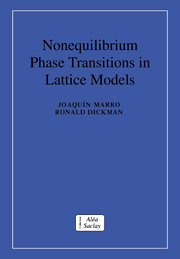4 - Lattice gases with reaction
Published online by Cambridge University Press: 29 September 2009
Summary
A class of biochemical processes is modeled by an open system into which reactants are continuously fed, and out of which products are continuously removed to maintain a steady nonequilibrium state. Studying such idealized models helps in understanding the formation and stability of complex spatial and temporal structures in biological systems. In a model with this aim, one needs ultimately to assume that molecules also diffuse. Systems that are governed by an interplay of reaction and diffusion processes are relevant to many problems in physics and other disciplines (Turing 1952). This chapter describes kinetic lattice gases whose dynamics involve competition between reaction and diffusion. The pioneering study of such stochastic models was due both to mathematicians and physicists; the more recent activity described below was motivated by theoretical as well as practical interest in related nonequilibrium situations.
The chapter is organized as follows. In §4.1, the nonlinear reaction–diffusion equation, a hydrodynamic-like description in which mean values and fluctuations have both spatial and temporal variations, is introduced. §4.2 presents a lattice model with competition between creation/annihilation processes at temperature T, and diffusion at temperature T′. The relation between the hydrodynamic and microscopic levels of description is examined in §4.3, and the implications of the resulting macroscopic equations are discussed in §4.4.
- Type
- Chapter
- Information
- Nonequilibrium Phase Transitions in Lattice Models , pp. 100 - 140Publisher: Cambridge University PressPrint publication year: 1999



